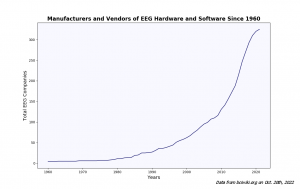If you're interested in becoming a contributor or requesting changes then click here to join the discord
A Quick Look at Applications for EEG
There are a number of companies today working on tools for reading and stimulating brain activity. Electroencephalography (EEG) is a technique for reading electrical activity resulting from fluctuations in mental states. Those readings have been successfully used for decades to diagnose sleep disorders and other conditions in the brain. EEG is also commonly used for neurofeedback therapy, neuromarketing research, and in brain-computer interfaces for paralyzed individuals.
Application Areas
Research
One of the “core” applications of EEG for many decades has been research. Without sales to labs doing EEG research, there wouldn’t be as many EEG manufacturers today, and EEG technology would be less advanced. Many EEG systems are in university laboratories devoted to research and teaching for neuroscience, psychology, psychophysiology and related fields. EGI and Neuroscan are just a couple of companies that provide hardware to research labs.
Sleep
Mind reading technologies like EEG are useful for measuring the various stages of sleeping and dreaming. Along with monitoring for problems in falling asleep and staying asleep, feedback can be used to improve sleep and even encourage lucid dream states.
Sleep Monitoring
Sleep clinics diagnose conditions like insomnia, sleep apnea, and narcolepsy with polysomnography. Polysomnography is a patient monitoring technique which uses EEG along with eye tracking, muscle activity, and heart rate to identify if and when sleep is disrupted.
Sleep Assistance
Some at-home wearable devices, such as the Dreem Headband attempt to improve sleep habits by playing music or tones during different stages of sleep. The Somnee headband is one example of a wearable that provides low power electrical stimulation for the same purpose.
Lucid Dreaming
Lucid dreams happen when you become aware that you’re dreaming while asleep. Although lucid dreaming is an uncommon occurrence for most people, it’s a skill that can be practiced and even used therapeutically for managing nightmares caused by chronic stress disorders.
Here are some examples of sleep monitoring companies: Advanced Brain Monitoring, Sleepmed, Bionen Medical Devices
Here are a few developing sleep assistance devices: Dreem, NYX, StimScience
And iBand+ is a company working on a lucid dreaming wearable.
Neurofeedback Therapy
Neurofeedback is a type of therapy which uses brain signals and feedback stimulation to reduce symptoms caused by neurological disorders and encourage healthy mental states. Feedback can include indirect audio cues, like those used by the Sens.ai headset, or visual feedback, like the FocusCalm score.
Some neurofeedback companies using indirect stimulation include Mindfield Biosystems, ScienceBeam, Neurosoft, Elmiko, MindMaze, Excellent Brain
Neurofeedback therapy can also involve direct electrical or magnetic stimulation of the brain. A good example being the IASIS neurofeedback device which uses microcurrent stimulation for relaxation training.
Other companies using direct stimulation techniques include Mended Minds, NeuroField, Foc.us, Ochs Labs, Ybrain, Neuroelectrics
Clinical Diagnosis and Monitoring
Finding and tracking the progression of neurological conditions are among the primary uses for EEG today.
Epilepsy
Epilepsy treatments benefit from locating the source and frequency of epileptic seizures.
Stroke and Traumatic Brain Injury
Abnormalities in signals across the scalp can assist in the diagnosis of mild or severe brain injuries caused by trauma, like a stroke or car accident.
Dementia
The development of dementia, a disorder characterized by impairments in memory and mental function, can be predicted using EEG biomarkers and potentially treated.
Intraoperative Neuromonitoring
Similar to sleep studies, EEG plays an important role in patient monitoring during surgical procedures. Measuring anesthesia, detecting seizures, and uncovering damage to the cortex caused during such procedures can greatly reduce the risk of neurological injury. Intraoperative Neuromonitoring (IONM) is the name for this process of monitoring the nervous system during an operation.
Coma
Recordings of brain activity are vital for diagnosing locked-in syndrome and monitoring developments in comatose patients. EEG also aids in communication with locked-in individuals.
Depression
Resting state recordings of individuals with depression can inform decisions on therapy options.
Here are some diagnosis and long term monitoring companies: AddBrain, Ives EEG Solutions, Holberg EEG, Cognision. And some that use EEG for intraoperative neuromonitoring: IntraNerve, Inomed, Bionen Medical Devices.
Brain-Computer Interfaces (BCI)
Compared to invasive techniques, brain waves recorded from the scalp are a limited source of information about underlying neural mechanisms. This information, however, is sufficient to enable basic control of machines and software through what is known as a brain-computer interface (BCI).
Assistive Technologies
Typing applications are useful for individuals whose communication abilities are limited by muscular deficits. Control over prosthetics can also benefit from EEG based brain-computer interfaces.
These neurotech companies are working on assistive technologies for communication: NeuroChat, NURO, Cognixion
General Computer Control
Affordability of consumer headsets has helped to encourage the development of all sorts of brain-computer interface projects and software.
These are some examples of general BCI companies: OpenBCI, Petal, EMOTIV, Neurable
Gaming
Video games seem to represent a major driving force in the commercializations of EEG devices for non-clinical use.
NextMind and Cortex Machina are a couple of companies integrating brain-computer interfaces with video games.
The Unicorn Brain Interface and intendiX system from g.tec are a couple of BCI systems designed for all of these use cases. In the grand scheme of EEG sales, BCI has played a small role until recently.
